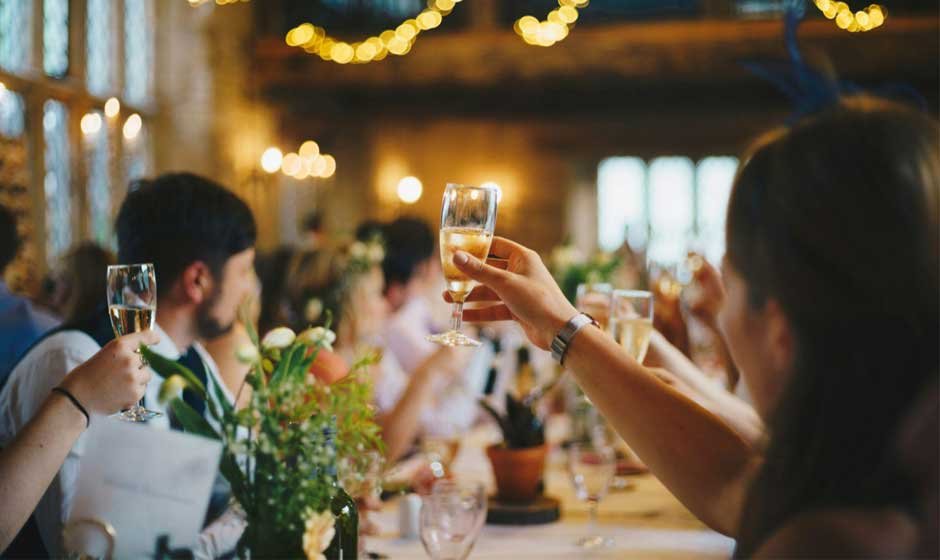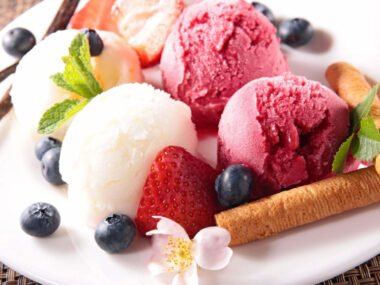Guests won’t remember the table runners. They won’t care that the napkins were folded into swans. What they do remember is whether the food was worth eating. A wedding menu sets the tone. It’s the difference between a reception that feels alive and one that drags.
A mediocre menu makes the night forgettable. People eat quickly, drink more to compensate, and leave early. A thoughtful menu keeps people at the table, talking, and engaged. It’s not decoration. It’s structure. The food is the timeline that everything else hangs on.
The Default Menu Problem
Most weddings default to a safe trio: chicken, salmon, or beef. A vegetarian option for courtesy. Dessert is a towering cake that looks flawless and tastes dry. Nobody complains, but nobody remembers it either.
The issue isn’t cost. It’s habit. Venues recycle the same menus because couples rarely challenge them. The result is an event that looks expensive but feels generic. You spent months planning, but the one thing everyone actually consumes is treated like filler.
Food as Identity, Not Obligation
Food is shorthand for who you are. It’s how you socialize, how you celebrate, how you travel. Choosing a menu that reflects your identity is not about being trendy. It’s about being accurate.
If you eat ramen at midnight, why not serve it at your wedding? If you bonded over sushi dates, make that the cocktail hour. Food doesn’t have to be symbolic. It just has to feel like you. That authenticity is what makes the meal stand out.
Why Interactive Stations Work
Interactive food stations do more than feed people. They create energy. Sushi rolled in front of you. Pasta tossed in a skillet and plated hot. Guests line up, choose toppings, talk to each other while waiting. It breaks the stiffness of sitting through a plated three-course meal.
It also solves a practical issue: not everyone wants the same thing. Stations give people choice. Choice makes people happier. Happier people dance longer, stay later, and tell you afterward that your wedding was fun.
Cocktail Hour as First Impression
The cocktail hour sets expectations. Serve tired cheese cubes and bruschetta, and guests assume dinner will be just as uninspired. Serve oysters, dumplings, or bao buns, and they perk up. The signal is clear: this wedding will be different.
It doesn’t need to be elaborate. Small, intentional bites are enough. The point is not volume. It’s tone. If cocktail hour feels thoughtful, the entire reception feels elevated.
Rethinking Dessert Beyond Cake
Traditional wedding cakes are impressive in photographs but underwhelming in reality. Guests take one bite, leave it on the plate, and move on. Dessert tables, donut walls, gelato carts, or mini pies keep people interested.
Dessert is often the last thing people taste before leaving. If it’s disappointing, it drags down the memory of the night. If it’s surprising, it reinforces the energy you worked to build.
Comfort Food Done Right
Comfort food works when elevated. Truffle mac and cheese in ramekins. Mini fried chicken sliders with pickled slaw. Pizza with artisanal toppings instead of greasy takeout.
The appeal is familiarity. Guests know the flavors. What makes it memorable is the execution. A basic dish delivered with precision outperforms an expensive dish served badly.
The Late-Night Shift
By midnight, nobody wants another slice of cake. They want food that soaks up alcohol and keeps them standing. Pizza boxes, pretzels, ramen cups. The late-night food table isn’t about elegance. It’s about endurance.
This is one of the most talked-about parts of a wedding because it hits when guests need it most. They’ll remember the snacks long after they forget the centerpieces.
Cultural Menus Add Meaning
Including cultural food isn’t optional if you want the event to feel personal. Nigerian jollof rice, Korean BBQ skewers, Mediterranean mezze, Indian curries. These menus aren’t just unique. They root the event in your actual story.
Guests notice. They remember that the food felt different from every other wedding they’ve been to. They also learn something about you that flowers and speeches can’t explain.
The Practical Side of Catering
Good catering is more important than décor. Linens, chairs, and uplighting are background. Food is the foreground. Every guest interacts with it. Every guest forms an opinion.
A skilled caterer manages logistics, flow, and timing. They understand how to feed 150 people without the food arriving cold. They also help you edit ideas into something realistic. It’s not just about creativity. It’s about execution.
Matching Food to Venue
A barn wedding works with farm-to-table menus. A city rooftop fits modern, minimalist plating. A beach wedding needs seafood. The venue dictates mood, and the food should match it.
Menus that ignore the venue feel disjointed. Guests notice when the food and setting don’t align. Cohesion matters more than extravagance.
Finding Inspiration Without Falling Into Trends
Pinterest boards are helpful, but they’re also dangerous. Trends age quickly. What looks exciting today can feel dated in a year. Start with your own habits. Where do you eat out? What meals do you crave? What flavors remind you of important moments?
From there, look outward. Travel, restaurants, or caterers with curated wedding food ideas can spark options you wouldn’t imagine on your own. The best inspiration feels relevant to you, not just staged for photos.
Food as Guest Experience
Guests don’t remember exact dishes. They remember how they felt. Did the food make them comfortable? Did it give them energy? Did it make the night feel generous?
Food is intimacy. It’s the one part of the wedding every guest directly experiences. That makes it more important than flowers, outfits, or music. All of those set atmosphere. Food sets memory.
Budget Doesn’t Excuse Boring Food
Couples often assume good food requires a big budget. It doesn’t. It requires intention. Fewer dishes done well is better than many dishes done poorly. A small plate that surprises is more memorable than a buffet that overwhelms.
Editing is part of the process. You don’t need everything. You just need the right things.
Editing Out the Basic Choices
The goal is not to reinvent the wheel. It’s to avoid autopilot. Don’t choose chicken because everyone else did. Don’t default to cake because it’s expected. Look at each decision and ask: does this feel specific to us, or does it feel like filler?
If it feels like filler, cut it. Weddings are long. People don’t need more filler.
Would You Eat This On Any Other Day?
If you wouldn’t order it at a restaurant, don’t serve it at your wedding. That’s the simplest test. Guests know when a menu has been designed for appearances instead of appetite. They also know when a meal feels like it was chosen by real people.
Food is supposed to be eaten, not staged. Apply that filter and you won’t end up with a menu that feels basic.
Choose Food That Feels Like You
The easiest mistake is outsourcing your taste to tradition. You don’t need to be radical. You just need to be specific. Choose food you actually like. Choose food that fits your story. Choose food that guests will eat, not just photograph.
When the plates are cleared, guests won’t remember the napkins or the centerpieces. They’ll remember whether the food was worth it. Don’t give them the same plate they’ve seen at every other wedding.










